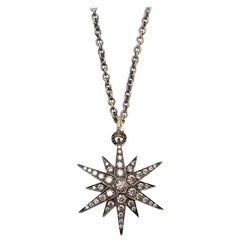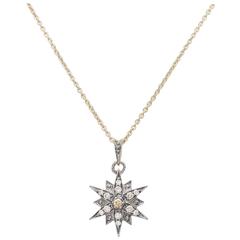H Stern Stars Necklace
Recent Sales
21st Century and Contemporary Brazilian Early Victorian Pendant Necklaces
Brown Diamond, 18k Gold
Late 20th Century Pendant Necklaces
Diamond, Gold, 18k Gold, Rhodium
H. Stern for sale on 1stDibs
Born into a Jewish family in Essen, Germany, Hans Stern (1922–2007) fled with his parents to Rio de Janeiro at the onset of World War II. There he landed a job working for the precious stone and mineral exporter Cristab. Thus began Stern’s rise to become “the king of the colored gems,” as the media would dub him, and founder of the family-owned H.Stern jewelry business that now has over 150 stores worldwide.
While working for Cristab, Stern regularly visited mines on horseback. At the remote mines of Minas Gerais, Brazil, he cultivated relationships with many of the miners, developing professional connections that would endure for decades. He also embraced a fascination with the colorful semiprecious stones harvested in the area. In 1945, he started his own company, H.Stern, with the goal of marketing Brazilian gemstones — then virtually unknown on the global stage — to an international audience.
Though the company began as a trader in gemstones, it soon expanded to jewelry, with Stern assembling and training a team of young jewelers. A frequent motif in the company’s designs was the star, as Stern is “star” in German. In 1949, H.Stern opened its first jewelry shop in Rio de Janeiro, but a storefront was not his customers’ only view into the brand’s jewelry-making process. In the 1950s, Stern became one of the first major jewelers to offer tours of his workshop, showing off the creative process and elevating the role of craftsmanship in jewelry design.
Stern’s approach and his vibrant jewels, which favored organic settings designed to show off colorful gems, earned international recognition and put Brazil’s topaz, amethyst and tourmaline on the map. Tourmaline was reportedly Stern’s favorite, and the company’s Rio de Janeiro vaults are also home to Paraíba tourmalines, which are mined in the mountains of Paraíba, Brazil. He recognized the burgeoning tourism industry in the country as an opportunity to promote the beauty of these stones, opening stores in the lobbies of Brazil’s leading hotels and investing in vehicles to bring visitors to the H.Stern headquarters. By the mid-1990s, the company was opening stores abroad and selling jewelry at international department stores.
In the 1980s, the brand debuted its first celebrity collaboration, with French actress Catherine Deneuve. Since then it has worked with partners such as designer Diane von Fürstenberg and architect Oscar Niemeyer. In 2016, Assouline published a book on the 70-year history of H.Stern, from its humble founding to its worldwide acclaim. Today, the company is run by Stern’s son, Roberto, who has introduced a broad range of new collections and styles.
On 1stDibs, find a collection of H. Stern necklaces, rings, earrings and other accessories.
The Legacy of Diamond in Jewelry Design
Antique diamond rings, diamond tiaras and dazzling vintage diamond earrings are on the wish lists of every lover of fine jewelry. And diamonds and diamond jewelry are primarily associated with storybook engagements and red-carpet grand entrances — indeed, this ultra-cherished gemstone has a dramatic history on its hands.
From “A Diamond Is Forever” to “Diamonds Are a Girl’s Best Friend,” pop culture has ingrained in our minds that diamonds are the most desired, the most lasting and the most valuable gemstone. But what makes the diamond so special? Each stone — whether it’s rubies, sapphires or another stone — is unique and important in its own right. April babies might claim diamonds for themselves, but just about everyone wants this kind of sparkle in their lives!
There are several factors that set diamonds apart from other stones, and these points are important to our gem education.
Diamonds are minerals. They are made up of almost entirely of carbon (carbon comprises 99.95 percent; the remainder consists of various trace elements). Diamonds are the hardest gemstones, ranking number 10 on the Mohs Hardness Scale. Even its name, diamond, is rooted in the Greek adamas, or unconquerable. The only object that can scratch a diamond is another diamond. Diamonds are formed deep within the earth at very high temperatures (1,652–2,372 degrees Fahrenheit at depths between 90 and 120 miles beneath the earth’s surface) and are carried up by volcanic activity. Diamonds are quite rare, according to the Gemological Institute of America, and only 30 percent of all the diamonds mined in the world are gem quality.
In the 1950s, the Gemological Institute of America developed the 4Cs grading system to classify diamonds: clarity, color, cut and carat weight. Not all diamonds are created equal (there are diamonds, and then there are diamonds). The value of the diamond depends on the clarity (flawless diamonds are very rare but a diamond's value decreases if there are many blemishes or inclusions), color (the less color the higher the grade), cut (how the diamond’s facets catch the light, certain cuts of diamonds show off the stone better than others) and carat weight (the bigger, the better).
When you start shopping for a diamond engagement ring, always prioritize the cut, which plays the largest role in the diamond's beauty (taking the time to clean your diamond ring at least every six months or so plays a role in maintaining said beauty). And on 1stDibs, a range of buying guides can be found for those in the market for antique engagement rings, vintage engagement rings or Art Deco engagement rings.
Shop antique and vintage diamond rings, diamond necklaces and other extraordinary diamond jewelry on 1stDibs.
Finding the Right Necklaces for You
We are fortunate to know much of the world’s long and dazzling history of necklaces, as this type of jewelry was so treasured that it was frequently buried with its owners. Today, Van Cleef necklaces, Tiffany necklaces and Cartier necklaces are some of the most popularly searched designer necklaces on 1stDibs.
Lapis lazuli beads adorned necklaces unearthed from the royal graves at the ancient Iraqi civilization of Sumer, while the excavation of King Tut’s burial chamber revealed a sense of style that led to a frenzy of Art Deco designs, with artisans of the 1920s seeking to emulate the elegant work crafted by Ancient Egypt’s goldsmiths and jewelry makers.
In ancient times, pendant necklaces worn by royalty and nobles conferred wealth and prestige. Today, wearing jewelry is about personal expression: Luxury diamond necklaces exude confidence and can symbolize the celebratory nature of a deep romantic relationship, while paper-clip chain-link necklaces designed by the likes of goldsmith Faye Kim are firmly planted in the past as well as the present. Kim works exclusively with eco-friendly gold, and these fashionable, fun accessories owe to the design of 19th-century watch fobs.
For some, necklaces are thought of as being a solely feminine piece, but this widely loved accessory has been gender-neutral for eons. In fact, just as women rarely took to wearing a single necklace during the Renaissance, men of the era layered chains and valuable pendants atop their bejeweled clothing. In modern times, the free-spirited hippie and counterculture movements of the 1960s saw costume-jewelry designers celebrating self-expression through colorful multistrand necklaces and no shortage of beads, which were worn by anyone and everyone.
Even after all of these years, the necklace remains an irrefutable staple of any complete outfit. Although new trends in jewelry are constantly emerging, the glamour and beauty of the past continue to inform modern styles and designs. In a way, the cyclical history of the necklace differs little from its familiar looped form: The celebrated French jewelry house Van Cleef & Arpels found much inspiration in King Tut, and, now, their Alhambra collection is a go-to for modern royals. Vintage David Webb necklaces — whose work landed him on the cover of Vogue in 1950, two years after opening his Manhattan shop — were likely inspired by the ornamental styles of ancient Greece, Mesopotamia and Egypt.
On 1stDibs, browse top designers like Dior, Chanel and Bulgari, or shop by your favorite style, from eye-catching choker necklaces to understated links to pearl necklaces and more.

